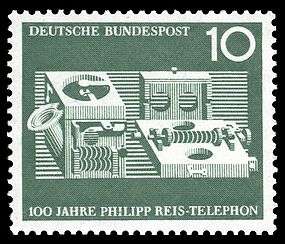Reis telephone

The Reis telephone was an invention named after Philipp Reis of a telephonelike device he constructed based on an idea inspired by a French article in 1854 by Charles Bourseul discussing microphonelike devices. Reis's first successful work is dated to October 1861.
History
In 1861, Philipp Reis succeeded in creating a device that captured sound, converted it to electrical impulses which were transmitted via electrical wires to another device that transformed these pulses into recognizable sounds similar to the original acoustical source. Reis coined the term telephone to describe his device.
In 1862, Reis demonstrated his telephone to Wilhelm von Legat, Inspector of the Royal Prussian Telegraph Corps who produced an account of it (Legat, 1862), a translation of which was obtained by Thomas Edison in 1875 and which was used in Edison's successful development of the carbon microphone. The Legat account included drawings that are different from that below, suggesting that it is of a later version. Edison acknowledged his debt to Reis thus:
The first inventor of a telephone was Phillip Reis of Germany only musical not articulating. The first person to publicly exhibit a telephone for transmission of articulate speech was A. G. Bell. The first practical commercial telephone for transmission of articulate speech was invented by myself. Telephones used throughout the world are mine and Bell's. Mine is used for transmitting. Bell's is used for receiving. (Edison 2006, [LB020312 TAEM 83:170])
However Reis's telephone was not limited to musical sounds. Reis also used his telephone to transmit the phrase "Das Pferd frisst keinen Gurkensalat" (The horse does not eat cucumber salad). Because this phrase is hard to understand acoustically in the German language, Reis used it to prove that speech can be successfully recognized on the distant end.[1]
Loudspeaker
Reis's speaker worked by magnetostriction. In his first receiver he wound a coil of wire around an iron knitting needle and rested the needle against the F hole of a violin. As current passed through the needle, the iron shrank and a click was produced. The image, below, shows an advanced version where the iron bar is clamped to a cigar-box-shaped resonator. This receiver is not very sensitive. It produces weak sound but has good fidelity. It requires very high current and is a current-sensitive device rather than a voltage-sensitive device.
This instrument could transmit continuous musical tones but produced indistinct speech. In 1865, however, British scientist David E. Hughes used the Reis telephone with "good results".[2]

See also
- Telephone
- History of the telephone
- Invention of the telephone
- Timeline of the telephone
- List of German inventors and discoverers
References
- Edison, Thomas A. 2006. The Edison Papers, Digital Edition Rutgers University, accessed 26 March 2006.
- Legat, V. 1862. "Reproducing Sounds on Extra Galvanic Way". accessed 26 March 2006.
- Friedrich Georg Wieck, Otto Wilhelm Ålund "Uppfinningarnas bok" vol. II, 1874.
- Thompson, Sylvanus P. "Philipp Reis, Inventor of the Telephone" London: E. & F.N. Spon, 1883.
- Coe, Lewis "The Telephone and Its Several Inventors: A History" Chapter 2, McFarland & Co, 1995.
External links
- "The Great Telephone Mystery" accessed September 5, 2006
- BBC - Bell 'did not invent telephone' - Dec 1 2003